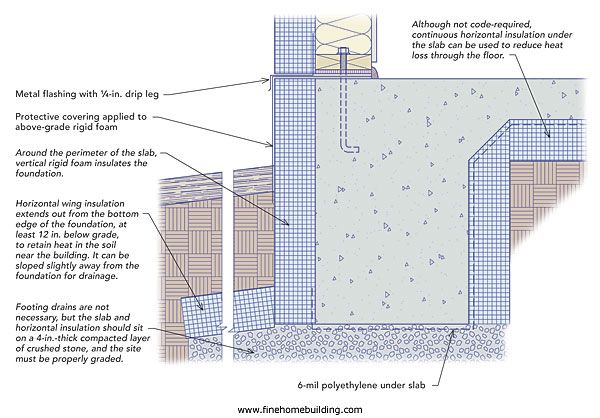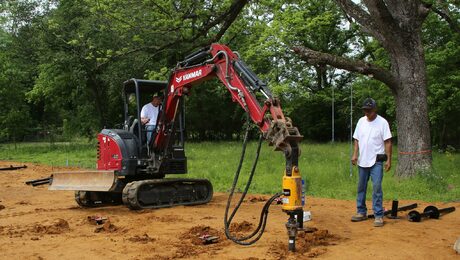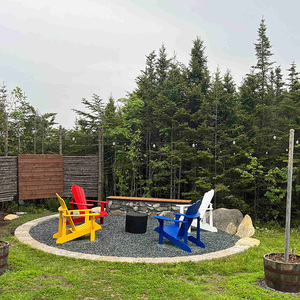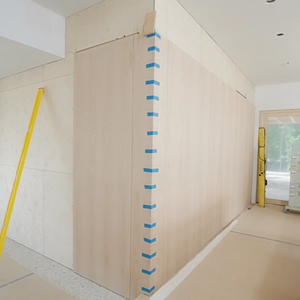What’s Better: Crawlspace or Slab-on-Grade?

Non_Trad_Stu’s 1400-sq. ft. house will be on one floor and constructed with structural insulated panels for energy efficiency. At least that much seems clear. But he’s uncertain of which type of foundation to use. His designer seems opposed to the use of insulating concrete forms for fear they could provide cover for termites. And that has led Non_Trad to wonder whether a slab-on-grade foundation would be better for him.
So, what are the pros and cons I’m facing with either approach?” he asks in the Breaktime Construction Techniques forum. “All I can think of is how foot friendly is concrete? How difficult/expensive is putting wood floor on top of concrete? What else do I need to take into account for either approach?”
More flexibility with a crawlspace
“My choice would be crawlspace,” Semar replies.
Not only would a crawlspace allow Non_Trad to keep all air ducts, along with the furnace, beneath the floor, but it also would provide easy access for servicing plumbing, electrical and telphone services. Another benefit: More flexibility with flooring, and the possibility of providing a curbless shower.
“I just have an aversity to hacking up concrete floors if I wanted to change/remodel something,” he adds.
Semar discounts the designer’s concerns that an ICF foundation might harbor termites because they have a solid concrete connection to the footing.
DanH suggests that if Non_Trad does go with a crawlspace he make it higher than the 18 in. required by code in most locations. A 2-ft. space would be better, he says, and more if you can get it.
“But pay attention to drainage,” Dan adds. “You don’t want the crawl filling up with water because it was dug low to meet the clearance requirement.
If increasing age, and decreasing mobility, are a potential issue with a crawlspace or basement, Junkhound isn’t buying it. Junkhound, “pushing 70,” would always favor a basement unless a high water table prevented it. In fact, his 89-year-old mother loves her basement, especially during the summer when she can escape the heat of central Illinois without running her air conditioner.
“Having a crawl space gives you an additional level in which to run your ducts, pipes, and wires,” adds Renosteinke. “This sure helps with later repairs and alterations. Putting in the piers ought to be no harder than prepping for a slab. As an added plus, a crawl space allows for a COMPLETE termite inspection.”
And on that score, Renosteinke recommends all the wood in the house be pressure-treated, “Not just at ground level…the critters can build 4-ft. tu”bes up to access wood, and some types fly.”
Slab is the way to go
Catherine, however, sees it differently.
“I just finished a slab-on-grade, SIPS home at the NC coast,” she writes, “and firmly believe that a slab is the only way to go.”
While crawlspaces are “nasty/ skinny/ moldy/ gross places full of spiders,” a slab can contain a radiant-floor heat distribution system that will keep Non_Trad’s toes warm in winter. Put in solar panels to warm the water, she adds, and take advantage of North Carolina’s generous incentives for renewable energy.
“Slab-on-grade gets my vote, too,” says Rdesigns. Among Rdesign’s other recommendations: 4 in. of foam installed horizontally around the floor perimeter, HVAD ducts and equipment inside the conditioned space (not the attic), and centralized plumbing.
“Stained concrete floors are durable, attractive and cheap,” Rdesign writes. “So are area rugs. No worries about crawlspace moisture, crawlspace vents or crawlspace critters or mold. True, you can’t have a wine cellar under the house, so just buy a free-standing climate-controlled one instead.
“Live it up–you’re only 74.”
Except that concrete is hard
The fact that concrete is its own finish floor is certainly an advantage, saving both time and materials in construction while opening the door to a variety of stained and acid-etched finishes.
As Catherine adds, concrete won’t harbor any allergens and it’s easy to keep clean.
And DanH wonders whether its reputation for brutal hardness underfoot is “more psychological than real.”
Hardly, says Sapwood. “I suspect that you haven’t spent a good deal of your working life standing on a concrete floor. Psychological or not, a concrete floor is less forgiving on my ol’ legs than wood, dirt, or just about anything else. Slabs are awfully hard. My past two shops have been slabs on grade. Great work surfaces but hard to stand on for all day. Something to consider depending on what your standing/sitting ratio is in the house. ”
If that’s the case, why do people like tiled kitchens so much, DanH asks.
Some don’t.
“I don’t love tile in the kitchen,” says Aimless. “It is hard, unforgiving, and cold. Add to that trying to keep grout lines clean is a pain in the kiester. Tearing out the tile and replacing with vinyl is high on my list of improvements for this home.”
Fine Homebuilding Recommended Products
Fine Homebuilding receives a commission for items purchased through links on this site, including Amazon Associates and other affiliate advertising programs.

Handy Heat Gun

Reliable Crimp Connectors

Affordable IR Camera

A frost-protected slab would allow you to build a slab-on-grade home in a cold-climate zone























View Comments
"a slab can contain a radiant-floor heat distribution system that will keep Non_Trad's hoes warm in winter"
Getting a little personal aren't we?
You're probably right, cussnu2. I changed it to "toes".
In a smaller home a crawlspace offers the opportunity to move the mechanicals outside of the living space. Our air handler, tankless water heater, water pump, ductwork and plumbing are all located in our conditioned crawlspace. Radiant floor heat can easily be installed between the joists. The space is conditioned, so no dampness and creepy things. Using this space maximizes the living space above.
My wife and I are in the exact same position right now. We are currently designing a Passive House that we will be building in the spring. We are going to use this as a test project for my company so costs are a big factor in our decision. If we can cut costs somewhere that doesn't affect the integrity or overall look of the building, then we need to consider it.
A slab on grade is one of those areas were we can save on costs. Basically, we save on the excavation, framing materials, labour and potentially floor covering. Also, we are not even considering radiant heat. Since it is a Passive House, we can save costs on the heating system. Proper insulation below the concrete slab in a well insulated house should keep your floor at a comfortable temperature.
Another factor we need to consider is accessibility. This is not our "forever" house so we want to market to a large population when we sell. For a small extra cost, we can make all of our doors 36" wide. There will be a second story to the house but the stairs will be in a location where a chair lift can easily be installed. The crawl space will be virtually impossible to access for a homeowner with accessibly issues.
The one thing I do like about the crawl space is the accessibility to plumbing. The electrical and mechanical will not be an issue in our design. Electrical wires can easily be fished and how often do you really need to move your mechanical pipes? We're thinking of using mini-splits so we won't have a furnace, however, if you have a furnace, your runs will be under the windows. Since our home will be open concept, there will be limited walls for the returns to go, so those would most likely have to stay where they are in spite of any major renovation (unless walls are added). The HRV or ERV ducts fall into the same category. Either way, I think planning for future renovations is virtually impossible. A well designed house will (hopefully) only need minor renovations to accommodate the different styles of different home owners.
Now that I have written that out, I think I have just made up my mind to go a slab on grade... Unless somebody else sees something I have missed...
Every type of construction has its own advantages and disadvantages?
I suggest slab on grade is the best design!
One's feet have a temperature of 30 degrees C/38F, this means that heat is always moving from our feet into the floor, which is going to be 22/72 or less.
Keeping in mind that heat always moves to cold and that concrete is able to absorb massive amounts of heat before it rises one degree, then concrete floors are out.
However, by moving the insulation above the concrete floor and topping the insulation with a OSB or wood floor less heat is lost downwards from our feet and our warm air and the home is cheaper to heat and the ambience is better.
Better is having the UFH just below the OSB floor and above/in the insulation, it is quicker to heat and quicker to cool.
The best solution is, Carpet, underlay, OSB, UFH/insulation, concrete.
Living in a waterfront community in NJ, I have to profess my preference for a crawl-space. Most of the houses built on slab foundations were flooded during the tidal surge caused by Sandy. My home was spared the worst by being just a couple of feet higher on a crawl-space. Of course this is not a factor for all locations, but it should be a consideration.
Was even the bottom of the crawlspace a few feet higher? Or did the crawl space flood?
Insulation below the concrete slab will allow for in-slab heating, using the mass of the concrete as a "night storage heater, evening out the effect of the boiler not running at night.
Ceramic or stone tile are minimum upkeep. Put down the gell pads in the standing areas of the kitchen, as is done in every commercial kitchen.
Spiders? Really?
The comments on the disadvantages of crawlspaces are just horse and buggy thinking: Crawlspaces should be completely sealed and the walls insulated. Doing so not only saves huge amounts of money on insulation and fill+concrete, but also offers far better potential energy efficiency because thermal transfer from those warm floors through stratified air to ground will be vastly less than through even relatively thick slab insulation. Dig a deep enough crawl space and you can even put your ERV and hot water and solar storage tanks down there, freeing up living space. We've done not only that, but have our swamp coolers down there too where they're protected from the elements (e.g., freezing). Of course, due to soil conditions and flood plain requirements the floor of our crawl space ended up being 5' below the joists. We also have staple-up hydronic heating which not only cost a fraction of what a slab+insulation would have (we did the install ourselves, so not counting labor of course) but it is also far more responsive than a slab-based system which can take days to heat up or cool down.
I am a recently retired general contractor and home/building inspector. I inspected thousands of buildings in my career, most with crawl spaces. Here on the Oregon coast where it rains 60 to 100 inches a year, the biggest challenge is moisture. If the site location, excavation and roof and ground drainage are not thoughtfully and properly done there will be moisture problems whether it is a crawl, slab or basement. Sometimes, even with the best efforts and expertise, it is an issue. In this wet climate I don't like slabs for most houses. With meticulously attention to detail, you might be able to eliminate moisture from migrating into the living space, but it is challenging at best. Concrete is a sponge and attracts moisture. Even if you can keep moisture from coming through the bottom and exposed perimeter edges, the wood framing and siding is too close to the ground, unless a concrete or block foundation stem wall is installed on top of the slab. There needs to be sufficient clearance from the ground to wood materials. With the subterranean termites that thrive in our climate, I do not like foam insulation underneath or around the edges of slabs and foundations. I have removed too much of it and found termites.
And, yes, crawl spaces are not without their problems, but if done correctly with AMPLE (More than code requirements) clearance and access it can be a good system. I think a completely sealed space with insulated sidewalls is the best way to go. I also agree that, wherever possible, a basement is the best of all worlds.
Looking at the illustration at the top of this page - how is that *not* an ICF wall done with extra effort? Even if you do go slab-ob-grade, consider using ICFs to form the outer edge. Save on making forms and removing them. You'd need to trim some inner top edge - easy with a bread knife or similar tool.
As for the idea that ICFs would harbour termites… well, how is foam added later any different to foam included at the beginning?
The slab on grade floor of my new wheelchair friendly house has developed big cracks and breaks throughout. Apparently tieing the rebar in the floor to the stemwalls held the perimeter of the floor down while the center of the floor heaved upward due to expansive soil. A crawlspace with adjustable piers would have allowed me to relevel the floor to compensate for soil movement.
Well, it kinda depends on where you are building.
In the San Jose, CA area we have areas of extreme expanding adobe clay soil and the cost to engineer/construct a post tension slab versus a pier and grade beam are about the same on a one-off house.
Other areas of town are on silty clays and not subject to extreme soil expansion and it is possible to build a slab on grade house.
Few small spec builders in the area use a slab on grade foundation as a sub-floor is seen as "quality" and a slab on grade is for "the big home builders".
Thanks for this post.you might be interested in checking out fine luxury homes by Brejnik Fine Homes (www.brejnik.ca). They build fine luxury houses. Brejnik team consists of qualified and trusted: Architects, Interior Designers, Appraisers / Lenders, Trades & Suppliers, Geo-technical engineers, Structural Engineers, Arborists, Landscape Architects, Pool & Water Feature.
Another alternative that the author could have addressed is a piered slab or structurally support slab. These cost a bit more than slab on ground foundations but have the ability to resist the typical differential movements experienced, especially in areas of expansive soils. Further, they trump pier and beam foundations with unconditioned crawl spaces in that there is not a resident mold factory below your house.
While it is true that pier and beam foundations with conditioned crawl spaces may be superior, they are difficult to build given the lack of skill levels among most of today's residential tradesmen. And, let's not forget, they are quite a bit more expensive.
When I read articles on "crawlspace or slab" I've always noticed that the PRO items for crawlspaces far outweighs the Pro items for slabs. There are plenty that like slabs, but for almost every "pro" those fans give, there is an equal (and many times, bigger) "pro" for crawlspaces. I've lived on both and can tell you that a slab - however it is done, is brutal to the body. On top of that, if it doesn't have some kind of significant insulation either below it or above it between the finished floor (which I would wager well over 90% do NOT have, it is a terrible COLD sink. I live in the south east, but in first (very nice and large) house, I literally cold cold draft currents in the winter coming up from the floor (raised slab with pre-finished hardwood on top). It took me half the winter to figure out what it was, but when I finally did I had to put down a significant amount of area rugs to try and combat that. As noted by some on here, through extensive research and personal experience I've determined that if you can't have a basement you should have a crawlspace (and I'd say AT LEAST 30" clearance) that is fully insulated/sealed. You will have ALL the best features of warthm on the floor, easy access to mechanicals and the ability to make modifications or repairs, easy access to check for termites or any other concerns you might have - and your house will simply look better. Where we live, many are slab-on-grade and the houses look so flat and unfinished when there is barely any difference between the front door and the grass or landscape in front of it. A home, no matter its design, can every really look "stately" that way.
We had a slab on grade building. To prep for hardwood flooring, we first sealed the concrete with Mapai Plainseal MSP then added 3/4 xps foam with taped seams. Then 3/4 plywood. We then screwed the assembly to the concrete with tapcons. We plan to install 3/4 engineered hardwood on top of this assembly.
I was surprised how comfortable the floor feels compared to concrete slab. The humidity has also dropped significantly.
I am currently having this internal debate for my new home I am designing. Crawlspace vs. slab on grade. I had originally wanted to go with a slab on grade with radiant in slab heating, but I don't want hard concrete floors as they are just too hard on the body. I am in a cold climate, zone 4 so no matter which route I go it will take a large amount of insulation. The other issue with a slab is the positioning of plumbing fixtures, if that isn't exactly 100% perfect then you have to live with something like a toilet that is off center by a bit. That may not sound like much, but those little details bug me and I would see it every time I looked at the toilet. So now as you might have guessed, I am leaning more towards the crawlspace. I do have the concern of moisture in the crawlspace as that can be a real issue, however I am thinking I could also install a dehumidifier that drains into a drain in the crawlspace to ensure it stays dry. The other issue with a crawlspace is air circulation, so I guess I need to make sure my air exchanger is sufficient to handle keeping the air well circulated in the crawlspace as well as the rest of the house. And lastly building an access hatch to the crawlspace would need to be done with care to ensure it is well sealed from the main floor. I also noticed in a post above that someone had mentioned that you can still do radiant floor heating with a crawlspace, so I will need to look into that option more.
As a question, my wife and I have a lot on a lakefront with a relatively high water table. All the houses there that I know of with crawlspaces fill with water (to the extend of having a pond under the house). Obviously that's not something we want.
Is there any reason that you cannot put down a slab, then enclose a crawlspace above the slab, then the house above? Or is this prohibitively expensive? I dislike the idea of utilities being inaccessible under a slab, having a pond under the house is obviously unacceptable, too.
Thank you for any responses.
Kevin